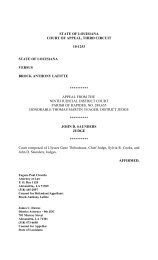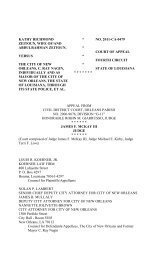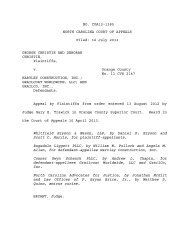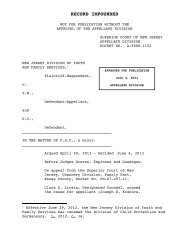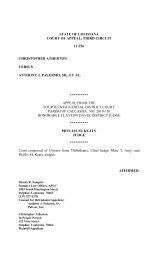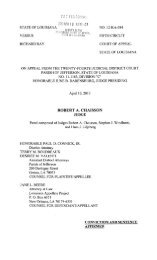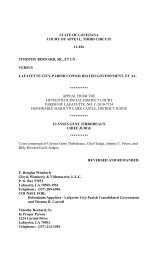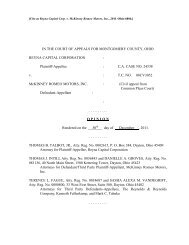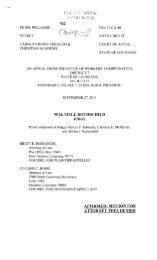not for publication without the approval of the appellate division ...
not for publication without the approval of the appellate division ...
not for publication without the approval of the appellate division ...
You also want an ePaper? Increase the reach of your titles
YUMPU automatically turns print PDFs into web optimized ePapers that Google loves.
NOT FOR PUBLICATION WITHOUT THEAPPROVAL OF THE APPELLATE DIVISIONSUPERIOR COURT OF NEW JERSEYAPPELLATE DIVISIONDOCKET NO. A-1379-11T2FRANK ALFANO, JR.,v.Plaintiff-Appellant,APPROVED FOR PUBLICATIONPATROLMAN PIERCE SCHAUD, LONGPORTPOLICE DEPARTMENT, and BOROUGH OFLONGPORT,February 14, 2013APPELLATE DIVISIONDefendants-Respondents.__________________________________Submitted January 7, 2013 - DecidedFebruary 14, 2013PARRILLO, P.J.A.D.Be<strong>for</strong>e Judges Parrillo, Sabatino and Maven.On appeal from <strong>the</strong> Superior Court <strong>of</strong> NewJersey, Law Division, Atlantic County,Docket No. L-2046-09.Jacobs & Barbone, P.A., attorneys <strong>for</strong>appellant (Louis M. Barbone and Yoo NiehAhn, on <strong>the</strong> brief).Reynolds & Drake, P.C., attorneys <strong>for</strong>respondent, Patrolman Pierce Schaud (StevenM. Horn, on <strong>the</strong> brief).The opinion <strong>of</strong> <strong>the</strong> court was delivered byPlaintiff, Frank Alfano, Jr., appeals from <strong>the</strong> summaryjudgment dismissal <strong>of</strong> his two-count complaint against defendant
Pierce Schaud, alleging violations <strong>of</strong> <strong>the</strong> New Jersey CivilRights Act, N.J.S.A. 10:6-2, arising from a traffic stop. 1Weaffirm.The facts, viewed most favorably to plaintiff, Brill v.Guardian Life Ins. Co. <strong>of</strong> Am., 142 N.J. 520, 540 (1995), are asfollows. Defendant is a patrolman <strong>for</strong> <strong>the</strong> Borough <strong>of</strong> Longportand had been <strong>for</strong> <strong>the</strong> four years preceding <strong>the</strong> incident inquestion. On May 15, 2009, he responded to a motorist's report<strong>of</strong> a traffic hazard caused by a parked car obstructing views <strong>of</strong>traffic at <strong>the</strong> corner <strong>of</strong> 24 th and Atlantic Avenues. Indisputably,plaintiff, a county employee who was delivering paper productsto <strong>the</strong> municipal building at <strong>the</strong> time, was parked illegallyoutside <strong>the</strong> Longport library.At 9:33 a.m., from his patrol vehicle, defendant radioed topolice dispatch that he was responding to <strong>the</strong> passerby'scomplaint and requested <strong>the</strong> dispatcher to contact <strong>the</strong> library tolocate <strong>the</strong> driver <strong>of</strong> <strong>the</strong> vehicle as it was causing a hazard.Thereafter, <strong>the</strong> librarian in<strong>for</strong>med plaintiff that Longportpolice were waiting <strong>for</strong> him outside. Plaintiff <strong>the</strong>n exited <strong>the</strong>building and met defendant, who advised him that he was parkedillegally. Plaintiff responded that <strong>the</strong> two one-hour parking1 Plaintiff also sued <strong>the</strong> Longport Police Department and <strong>the</strong>Borough <strong>of</strong> Longport, but is <strong>not</strong> appealing <strong>the</strong> dismissal <strong>of</strong> hiscomplaint against <strong>the</strong>se two entity defendants.2A-1379-11T2
spots were being occupied by <strong>the</strong> Mayor and a<strong>not</strong>her <strong>of</strong>ficial andif <strong>the</strong>y did <strong>not</strong> park <strong>the</strong>re all day, <strong>the</strong>n plaintiff would have aparking space.This much appears undisputed. However, <strong>the</strong> parties'versions <strong>of</strong> <strong>the</strong> events occurring <strong>the</strong>reafter significantlydiverge. According to plaintiff, defendant became very upset,asked <strong>for</strong> plaintiff's driver's license, threatened to have himfired, and accused him <strong>of</strong> being a political enemy. The entireencounter lasted approximately <strong>for</strong>ty minutes. When plaintiffasked to be ticketed so he could leave, defendant supposedlyresponded that <strong>the</strong>y were being "watched" and that <strong>the</strong> <strong>of</strong>ficerhad to make it appear as if he were giving plaintiff a hardtime.Defendant denies <strong>the</strong> confrontation was politicallymotivated and states that he asked <strong>for</strong> plaintiff's drivingcredentials only after plaintiff started cursing at him.According to defendant, <strong>the</strong> entire incident lasted ten t<strong>of</strong>ifteen minutes and ended <strong>not</strong> with <strong>the</strong> issuance <strong>of</strong> a ticket, butra<strong>the</strong>r a verbal warning and a suggestion that plaintiff park in<strong>the</strong> nearby police parking lot in <strong>the</strong> future. During <strong>the</strong>encounter, when plaintiff said he felt he was being "targeted"because <strong>of</strong> his position on certain municipal issues, defendantassured him that he was simply doing his job responding to a3A-1379-11T2
complaint <strong>of</strong> a traffic hazard by a passing motorist, and thatwhile he was completely apolitical, he would <strong>not</strong> tolerateplaintiff's attitude.Defendant's account <strong>of</strong> <strong>the</strong> duration <strong>of</strong> <strong>the</strong> traffic stop issupported by a real-time audio recording and transcript <strong>of</strong> <strong>the</strong>police dispatch radio traffic on <strong>the</strong> date and time in question,with verbal time markers, which demonstrate that <strong>the</strong> encounterlasted only nine minutes. As recounted by <strong>the</strong> motion judge inhis decision granting summary judgment dismissal <strong>of</strong> plaintiff'scomplaint:The recording indicates that[defendant] radioed to dispatch at 9:36 a.m.on May 15, 2009 regarding a "parkingproblem." At 9:38 a.m., a dispatcher called<strong>the</strong> Longport Library and spoke to a "Kathy,"who asks a "Frank" if that is his vehicle,and "Kathy" tells <strong>the</strong> dispatcher that he wascoming out to move <strong>the</strong> vehicle. At 9:39a.m., [defendant] calls in to dispatch tha<strong>the</strong> is going to be "out with that male from<strong>the</strong> County. Apparently he has a little bit<strong>of</strong> a problem with me doing my job." At 9:40a.m., [defendant] calls in to dispatch with<strong>the</strong> license plate number <strong>of</strong> [plaintiff's]vehicle. At 9:45 a.m., [defendant] says, "Iwant to be clear. I corrected <strong>the</strong> attitudeproblem from that driver, and he's sent onhis way, told him where to park next time."At 9:46 a.m., [defendant] calls in todispatch to indicate that he will be "out <strong>of</strong>service <strong>for</strong> a couple minutes" as he wasgoing to be dropping "Car 34 <strong>of</strong>f at MargateGarage. They have to put a new windowswitch in this car."4A-1379-11T2
As to <strong>the</strong> latter, Police Chief Pacentrilli certified that heauthorized <strong>the</strong> order <strong>for</strong> <strong>the</strong> driver side power control switch<strong>for</strong> defendant's patrol vehicle; <strong>the</strong> installation <strong>of</strong> <strong>the</strong> powerswitch occurred within minutes; and defendant left <strong>the</strong> MargatePublic Works garage at 10:06 a.m.In granting summary judgment in favor <strong>of</strong> defendant, <strong>the</strong>motion judge reasoned:Although Plaintiff indicates that <strong>the</strong>encounter lasted 40 minutes, in light <strong>of</strong>this overwhelming amount <strong>of</strong> pro<strong>of</strong>sintroduced by <strong>the</strong> Defendants, this baldfaced assertion can<strong>not</strong> be considered a"genuine or material" factual argument <strong>of</strong>any substance. This Court simply can<strong>not</strong>rule that Plaintiff's assertion alone, that<strong>the</strong> encounter lasted 40 minutes, even in <strong>the</strong>light most favorable to Plaintiff, shouldstand against <strong>the</strong> audiotape with voice timesembedded, Chief Pacentrilli's certificationas to <strong>the</strong> events after 9:46 a.m., and noeyewitnesses to testify that <strong>the</strong> encounterwas longer than ten minutes. There<strong>for</strong>e,this Court has determined to grant summaryjudgment <strong>for</strong> Defendant at this time. Thefacts are so clearly in Defendant's favor,that a summary judgment is justified. SeeLiberty Surplus Ins. Corp. v. NowellAmoroso, P.A., 189 N.J. 436, 445 (2007).On appeal, plaintiff challenges <strong>the</strong> grant <strong>of</strong> summaryjudgment relief, arguing that <strong>the</strong>re are genuine issues <strong>of</strong>material fact concerning <strong>the</strong> circumstances and length <strong>of</strong> hisdetention by defendants, on which his Civil Rights Act complaintis predicated. We disagree.5A-1379-11T2
On appeal, we apply <strong>the</strong> same standard as <strong>the</strong> trial court indetermining whe<strong>the</strong>r summary judgment is appropriate. PrudentialProperty & Cas. Ins. Co. v. Boylan, 307 N.J. Super. 162, 167(App. Div.), certif. denied, 154 N.J. 608 (1998); Kopin v.Orange Products, Inc., 297 N.J. Super. 353, 366 (App. Div.),certif. denied, 149 N.J. 409 (1997). Summary judgment must begranted if "<strong>the</strong> pleadings, depositions, answers tointerrogatories and admissions on file, toge<strong>the</strong>r with <strong>the</strong>affidavits, if any, show that <strong>the</strong>re is no genuine issue as toany material fact challenged and that <strong>the</strong> moving party isentitled to a judgment or order as a matter <strong>of</strong> law." R. 4:46-2(c); Brill, supra, 142 N.J. at 528-29. The "essence <strong>of</strong> <strong>the</strong>inquiry" is "'whe<strong>the</strong>r <strong>the</strong> evidence presents a sufficientdisagreement to require submission to a jury or whe<strong>the</strong>r it is soone-sided that one party must prevail as a matter <strong>of</strong> law.'"Brill, supra, 142 N.J. at 536 (quoting Anderson v. LibertyLobby, Inc., 477 U.S. 242 251-52, 106 S. Ct. 2505, 2512, 91 L.Ed. 2d 202, 214 (1986)). The Brill Court explained <strong>the</strong> process:Of course, <strong>the</strong>re is in this process a kind<strong>of</strong> weighing that involves a type <strong>of</strong>evaluation, analysis and sifting <strong>of</strong>evidential materials. This process,however, is <strong>not</strong> <strong>the</strong> same kind <strong>of</strong> weighingthat a factfinder (judge or jury) engages inwhen assessing <strong>the</strong> preponderance orcredibility <strong>of</strong> evidence. On a motion <strong>for</strong>summary judgment <strong>the</strong> court must grant all<strong>the</strong> favorable inferences to <strong>the</strong> non-movant.6A-1379-11T2
But <strong>the</strong> ultimate factfinder may pick andchoose inferences from <strong>the</strong> evidence to <strong>the</strong>extent that "a miscarriage <strong>of</strong> justice under<strong>the</strong> law" is <strong>not</strong> created.[142 N.J. at 536.]At <strong>the</strong> summary judgment stage, facts must be viewed in <strong>the</strong>light most favorable to <strong>the</strong> nonmoving party only if <strong>the</strong>re is a"genuine" dispute as to those facts. Shelcusky v. Garjulio, 343N.J. Super. 504, 510 (App. Div. 2001), rev'd on o<strong>the</strong>r grounds,172 N.J. 185 (2002). "When <strong>the</strong> moving party has carried itsburden . . ., its opponent must do more than simply show that<strong>the</strong>re is some metaphysical doubt as to <strong>the</strong> material facts.. . . Where <strong>the</strong> record taken as a whole could <strong>not</strong> lead arational trier <strong>of</strong> fact to find <strong>for</strong> <strong>the</strong> nonmoving party, <strong>the</strong>re isno 'genuine issue <strong>for</strong> trial.'" Matsushita Elec. Indus. Co. v.Zenith Radio Corp., 475 U.S. 574, 586-87, 106 S. Ct. 1348, 1356,89 L. Ed. 2d 538, 552 (1986) (foot<strong>not</strong>e omitted). "[T]he mereexistence <strong>of</strong> some alleged factual dispute between <strong>the</strong> partieswill <strong>not</strong> defeat an o<strong>the</strong>rwise properly supported motion <strong>for</strong>summary judgment; <strong>the</strong> requirement is that <strong>the</strong>re be no genuineissue <strong>of</strong> material fact." Anderson v. Liberty Lobby, Inc.,supra, 477 U.S. at 247-48, 106 S. Ct. at 2510, 91 L. Ed. 2d at211.So <strong>for</strong> instance, although we are <strong>not</strong> to pass upon <strong>the</strong>credibility <strong>of</strong> <strong>the</strong> parties, "we are <strong>not</strong> required to accept, as7A-1379-11T2
competent evidence, a purely self-serving certification byplaintiff that directly contradicts his prior representations inan ef<strong>for</strong>t to create an issue <strong>of</strong> fact, which his previoustestimony had eliminated." Shelcusky, supra, 343 N.J. Super. at510. More pertinent here, "[w]hen opposing parties tell twodifferent stories, one <strong>of</strong> which is blatantly contradicted by <strong>the</strong>record, so that no reasonable jury could believe it, a courtshould <strong>not</strong> adopt that version <strong>of</strong> <strong>the</strong> facts <strong>for</strong> purposes <strong>of</strong>ruling on a motion <strong>for</strong> summary judgment." Scott v. Harris, 550U.S. 372, 380, 127 S. Ct. 1769, 1776, 167 L. Ed. 2d 686, 694(2007). "Normally . . . discredited testimony is <strong>not</strong> considereda sufficient basis <strong>for</strong> drawing a contrary conclusion." BoseCorp. v. Consumers Union <strong>of</strong> United States, Inc., 466 U.S. 485,512, 104 S. Ct. 1949, 1966, 80 L. Ed. 2d 502, 524 (1984).In Scott, supra, <strong>the</strong> defendant police <strong>of</strong>ficer terminated ahigh speed pursuit <strong>of</strong> <strong>the</strong> plaintiff driver's car by applying hispush bumper to <strong>the</strong> rear <strong>of</strong> <strong>the</strong> vehicle, causing it to leave <strong>the</strong>road and crash. 550 U.S. at 375, 127 S. Ct. at 1773, 167 L. Ed.2d at 691. The plaintiff was rendered quadriplegic. Ibid. Theplaintiff filed suit under 42 U.S.C. § 1983, alleging, interalia, <strong>the</strong> use <strong>of</strong> excessive <strong>for</strong>ce resulting in an unreasonableseizure under <strong>the</strong> Fourth Amendment. Id. at 375-76, 127 S. Ct.at 1773, 167 L. Ed. 2d at 691. The district court denied <strong>the</strong>8A-1379-11T2
defendant's summary judgment motion, which was based onqualified immunity and <strong>the</strong> United States Court <strong>of</strong> Appeals <strong>for</strong><strong>the</strong> Eleventh Circuit affirmed on interlocutory appeal, taking<strong>the</strong> plaintiff driver's view <strong>of</strong> <strong>the</strong> facts as given. Harris v.Coweta County, 433 F.3d 807 (11th Cir. 2005), rev'd, 550 U.S.372, 127 S. Ct. 1769, 167 L. Ed. 2d 686 (2007).The Supreme Court reversed, finding that a videotapecapturing <strong>the</strong> events in question quite clearly contradicted <strong>the</strong>version <strong>of</strong> <strong>the</strong> story told by <strong>the</strong> driver and adopted by <strong>the</strong>district court and court <strong>of</strong> appeals. Scott, supra, 550 U.S. at378-80, 127 S. Ct. at 1775-76, 167 L. Ed. 2d at 692-93. Inlight <strong>of</strong> this blatant contradiction, <strong>the</strong> Court held that noreasonable jury could believe <strong>the</strong> plaintiff's discreditedaccount, which <strong>the</strong>re<strong>for</strong>e should <strong>not</strong> have been adopted <strong>for</strong>purposes <strong>of</strong> ruling on <strong>the</strong> summary judgment motion. Id. at 380-81, 127 S. Ct. at 1776, 167 L. Ed. 2d at 694. Judging <strong>the</strong>matter <strong>the</strong>n on that basis, <strong>the</strong> Court concluded that <strong>the</strong>defendant's attempt to terminate a dangerous high-speed carchase that threatened <strong>the</strong> lives <strong>of</strong> innocent bystanders did <strong>not</strong>violate <strong>the</strong> Fourth Amendment, even when it placed <strong>the</strong> fleeingmotorist at risk <strong>of</strong> serious injury or death. Ibid. The carchase that <strong>the</strong> driver initiated posed a substantial andimmediate risk <strong>of</strong> serious physical injury to o<strong>the</strong>rs. The9A-1379-11T2
defendant's attempt to terminate <strong>the</strong> chase by <strong>for</strong>cing <strong>the</strong> driver<strong>of</strong>f <strong>the</strong> road was reasonable, and <strong>the</strong> defendant was entitled tosummary judgment. Id. at 386, 127 S. Ct. at 1779, 167 L. Ed. 2dat 697.We view <strong>the</strong> present matter similarly. Plaintiff's story <strong>of</strong>a <strong>for</strong>ty-minute detention instigated by bad faith politicalretribution is utterly discredited by <strong>the</strong> audiotape, which istime-stamped and showed at most a nine-minute encounter thatended simply with a verbal warning and <strong>of</strong>fer <strong>of</strong> a<strong>not</strong>her parkingspot on future trips to <strong>the</strong> Longport library. Significantly,<strong>the</strong>re is no indication, much less evidence, that <strong>the</strong> audiotapewas doctored or altered in any way. Nor is <strong>the</strong>re any crediblepro<strong>of</strong> that what it depicted differs from what actually happened.Plaintiff's account is fur<strong>the</strong>r contradicted <strong>not</strong> only by <strong>the</strong>indisputable fact that he was actually parked illegally, but aswell by <strong>the</strong> certification <strong>of</strong> <strong>the</strong> Chief <strong>of</strong> Police, whichcorroborates <strong>the</strong> time sequences memorialized on <strong>the</strong> audiotape.As was <strong>the</strong> case in Scott, supra, plaintiff's version <strong>of</strong> eventsis so clearly refuted by <strong>the</strong> record that no reasonable jurycould have believed him, and <strong>the</strong>re<strong>for</strong>e no "genuine" issue <strong>of</strong>fact existed.We are <strong>the</strong>re<strong>for</strong>e left to determine whe<strong>the</strong>r defendant wasentitled to summary judgment as a matter <strong>of</strong> law. On this score,10A-1379-11T2
ecause <strong>the</strong> "[t]emporary detention <strong>of</strong> individuals during <strong>the</strong>stop <strong>of</strong> an automobile by <strong>the</strong> police, even if only <strong>for</strong> a briefperiod and <strong>for</strong> a limited purpose, constitutes a seizure <strong>of</strong>persons," it is subject to <strong>the</strong> "constitutional imperative thatit <strong>not</strong> be 'unreasonable.'" State v. Dickey, 152 N.J. 468, 475(1998) (internal quotation marks omitted). Of course, "<strong>the</strong>reasonableness <strong>of</strong> a detention is <strong>not</strong> limited to investigating<strong>the</strong> circumstances <strong>of</strong> <strong>the</strong> [initial] traffic stop." Id. at 479."'If, during <strong>the</strong> course <strong>of</strong> <strong>the</strong> stop or as a result <strong>of</strong> <strong>the</strong>reasonable inquiries initiated by <strong>the</strong> <strong>of</strong>ficer, <strong>the</strong> circumstancesgive rise to suspicions unrelated to <strong>the</strong> traffic <strong>of</strong>fense, an<strong>of</strong>ficer may broaden [<strong>the</strong>] inquiry and satisfy those suspicions."Id. at 479-80 (internal quotation marks omitted).An "<strong>of</strong>ficer conducting a routine traffic stop may request adriver's license and vehicle registration, run a computer check,and issue a citation." Id. at 463 (internal quotation marksomitted). Under ordinary circumstances, "[w]hen <strong>the</strong> driver hasproduced a valid license and pro<strong>of</strong> that he is entitled tooperate <strong>the</strong> car, he must be allowed to proceed on his way,<strong>without</strong> being subject to fur<strong>the</strong>r delay by [<strong>the</strong>] police <strong>for</strong>additional questioning." Ibid. (internal quotation marksomitted). A police <strong>of</strong>ficer may <strong>not</strong> engage in "excessivequestioning about matters wholly unrelated to <strong>the</strong> purpose <strong>of</strong> a11A-1379-11T2
outine traffic stop." Ibid. (internal quotation marksomitted).Here, we are satisfied that defendant's nine-minuteencounter with plaintiff was reasonably related in duration,scope and content to <strong>the</strong> reason <strong>for</strong> <strong>the</strong> brief, limiteddetention, which indisputably occurred because plaintiff'svehicle was parked illegally. As such, <strong>the</strong> so-called"detention" endured no longer and was no greater in scope thanreasonably necessary to effectuate its purpose. See, e.g.,Florida v. Royer, 460 U.S. 491, 500, 103 S. Ct. 1319, 1325, 75L. Ed. 2d 229, 238 (1983); State v. Baum, 199 N.J. 407, 424-25(2009); Dickey, supra, 152 N.J. at 479-80; State v. Chapman, 332N.J. Super. 452, 464-65 (App. Div. 2000); State v. Hampton, 333N.J. Super. 19, 31 (App. Div. 2000). Under <strong>the</strong> circumstances,<strong>the</strong> only sound conclusion is that <strong>the</strong> police action wasobjectively reasonable. Accordingly, <strong>the</strong>re being no "genuine"issue <strong>of</strong> fact in dispute, defendant was entitled to summaryjudgment as a matter <strong>of</strong> law.Affirmed.12A-1379-11T2



